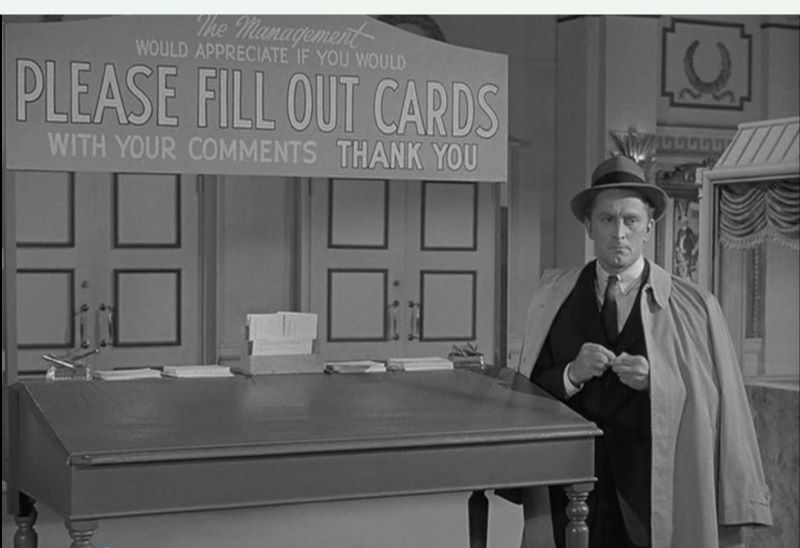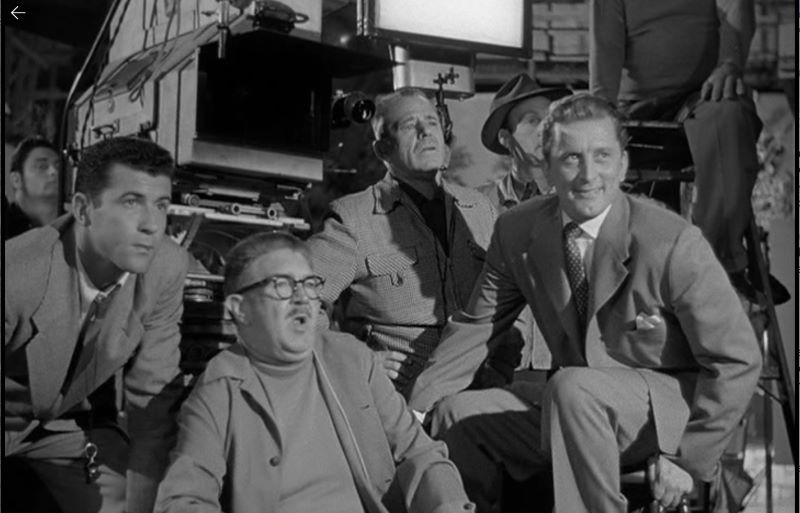
Hollywood today wrestles with the same rough-and-tumble corporate culture and marketing riddles that are illuminated in the1952 drama/satire “The Bad and the Beautiful.”
It’s a movie about movies spotlighting every corner of Hollywood including marketing matters that are still relevant today: agonizing over crafting promotional messages to turn heads; the behind-the-scenes vagaries of audience test screenings; and the tension between art versus commerce in cinema.
Kirk Douglas portrays a hustler film producer who in a brainstorming session with his director portrayed by Barry Sullivan becomes determined to make a monster movie without showing the monster. They decide to rely on implied horror.
“Alright, so what do we put on the screen that will make the backs of their necks crawl?” asks the producer.
“Two eyes shining in the dark,” responds the director.
“A dog, frightened. Growling..Showing its fangs,” adds the producer
“A bird. Its neck broken with feathers torn from its throat,” the director says with enthusiasm.
“A little girl screaming,” chimes in the producer. “Claw marks streaming down her cheeks.” The duo warm to the notion of darkness where audiences can project their own thoughts and fears.

Another section is centered around an audience test screening at a cinema that have the producer and director on edge because of uncertainty about how their creation will be received. They join a handful of executives afterwards poring over paper audience comment cards — a fixture of audience testing at the time — finding enthusiastic responses.
In the movie, Kirk Douglas waits impatiently in a theater lobby of a test screening for his film under a sign reading: “The management would appreciate if you would PLEASE FILL OUT CARDS with your comments. Thank You.”
“Ooh, wait until I flash these around the executive dining room” tomorrow at the studio, says the executive in charge as he gathers up the audience cards before leaving. The producer reminds that the studio brass should be told that it’s his success, to which the departing executive in charge says with a good-natured chuckle, “I don’t want to give you too much credit. Just enough to make you hungry for more.”

Film professor Kevin Doherty says the movie presents the full arc of filmmaking in the 1950s studio system and subtly explains “how you can sell film based on its budget. So, you had to conform to what the higher ups wanted. Personal visions of director and screenwriters often were submerged because of commercial considerations.” Doherty, who presents “Bad and Beautiful” in lectures, adds that, the smaller a movie’s budget, the more freedom for filmmakers. That’s because studio brass is more focused on big-budget films. Doherty was an adjunct professor of film at Manhattanville College and contributing editor for cinema book “A Spiritualist Style in Film.”
“Bad and Beautiful” is a Metro-Goldwyn-Mayer “A” picture that sports an all-star cast and received six Oscar nominations (winning five!). In addition to Douglas and Sullivan, Walter Pidgeon portrays an autocratic studio executive, Lana Turner is a self-destructive actress on the road to stardom and Dick Powell is a fish-out-of-water author/screenwriter. Though star laden and Oscar honored, the film is not particularly well-remembered despite its enduring wisdom and insights. It’s a cautionary tale that’s still relevant today in Hollywood. But that title is a little nondescript and dopey (its original title is the much-better ‘Tribute to a Badman”).
When released in 1952, MGM marketed the film mostly as a romantic potboiler melodrama, with its Hollywood insight a secondary selling point. “What goes on in the private lives of the famous and the notorious?” asks the voice-over in “The Bad and the Beautiful” original trailer. “You will share the laughter and the tears of talented people who will stop at nothing to attain success.”

The movie’s storyline is inspired by Val Lewton’s celebrated “The Cat People,” a 1942 horror film in which the feared beasts are never actually seen — then a novelty for horror films. “Bad and Beautiful” also spawned a sequel a decade later “Two Weeks in Another Town,’ and both come from director Vincente Minnelli.
“Bad and Beautiful” is an ode to snarky Hollywood itself that is dotted with subtle satire: the burial of a studio mogul is attended by paid mourners because the deceased had no friends; the brainstorming nature of piecing together movies; the relentless quest for one’s next job in Hollywood’s project-oriented economy; and the omnipresent deceit/betrayals/jockeying for position in the workplace.
It’s all timeless…
“Some of the best movies are made by people who hate each other’s guts,” the hard-charging producer tells his screenwriter. “Then we should make a great movie,” replies the screenwriter dryly. “I usually do,” answers the producer, unfazed by the sarcasm.
Earlier, two filmmakers quote their studio boss’ mantra that “I don’t want to win awards. I want to make pictures that end with a kiss and black ink on the books,” meaning a profitable movie even if predictably conventional.
The producer character sums up the ambition required to succeed as “If you dream, dream big.”
Related content:
Leave a Reply